[ad_1]
When Apple recently debuted its Vision Pro, one fascinating new feature that went unnoticed was how the mixed-reality headset could be used as a 3D camera. Not many immediately understood what the 3D camera could do. Apple was even ridiculed for promoting tech isolation by including a shot in the presentation that showed how a father was seen recording his children using the headset’s 3D camera.
Although that particular scene may not have gone well with some viewers, the idea of recording memories and revising them in a three-dimensional way has piqued interest in 3D cameras after a long time.
Now that 3D cameras are being discussed once again, we take a look at how 3D photography has evolved all the way from the 19th century to the present era.
3D and your eyes
Before you understand how a 3D camera works, you need to know the difference between 2D and 3D pictures. A 2D or two-dimensional picture is a flat image with just two dimensions – length and width. Meanwhile, 3D or third-dimensional pictures have a certain depth to them, giving a realistic representation of space.
Even though we live in a three-dimensional world, the images perceived by our eyes are two-dimensional. And still, everything we look at appears three-dimensional. Our eyes are approximately 6 cm apart, so they see the same images from slightly different angles and perspectives. Your brain then combines these two images in order to judge distance. This phenomenon is called binocular vision. Stereo vision, or ‘Stereopsis’ is a result of good binocular vision, wherein two separate images are combined into one 3D image.
 Wheatstone’s original Stereoscope has been preserved in the archives of Kings College, London, where he worked. (Image credit: King’s College, London)
Wheatstone’s original Stereoscope has been preserved in the archives of Kings College, London, where he worked. (Image credit: King’s College, London)
This 3D effect is possible due to the stereo depth perception we get from our two eyes. 3D glasses, the one you get at a movie theatre, also uses this technique to create the illusion of depth. When we wear them while watching a 3D movie, two pictures are shown at the same time, one to each eye. It’s really about tricking the brain into seeing a three-dimensional image.
How a 3D camera works
A 3D camera is an imaging device that uses the perception of depth to create a 3D environment, basically replicating how human eyes work. Such a 3D camera is designed to take advantage of the ‘Stereo Vision’ technique by deploying two cameras which are positioned parallel to each other.
The two cameras then capture the same images of the same object from slightly different angles at one fixed focal point. This results in a 3D image, thanks to how the camera’s two lenses record different points of view. The foundation of stereo vision is similar to 3D perception in human vision.
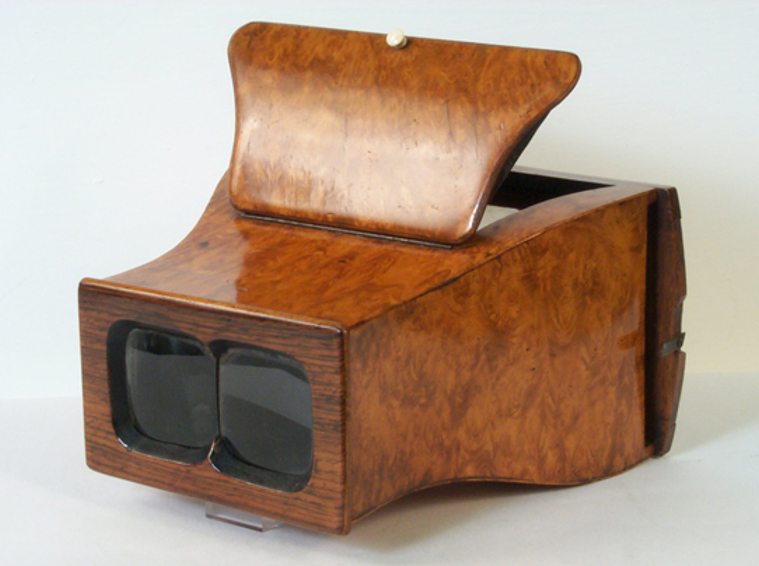 Sir David Brewster designed the first lens-based stereoscope in 1849, which was far more compact than Wheatstone’s model. (Image credit: Museo nazionale della scienza e della tecnologia Leonardo da Vinci, Milan)
Sir David Brewster designed the first lens-based stereoscope in 1849, which was far more compact than Wheatstone’s model. (Image credit: Museo nazionale della scienza e della tecnologia Leonardo da Vinci, Milan)
Origins of 3D pictures
The history of 3D pictures, or stereo cards, dates back to the 19th century. In 1838, British scientist Charles Wheatstone published a paper describing stereoscopy—a way to create an illusion of depth from two flat images photographed or drawn at slightly different angles. This was, as per his research, how our vision works. Wheatstone created a table-size device to demonstrate a three-dimensional effect by inventing a binocular device that he named a Stereoscope.
Although concept-wise the device was revolutionary, it had its share of flaws—it created irregular reflections, and the images weren’t clear enough. The Stereoscope that Wheatstone created wasn’t very popular among the masses until a decade later when Sir David Brewster re-looked at the device and tried to reimagine it.
While the Stereoscope that Wheatstone developed was made from daguerreotypes (a highly polished silver surface plate), Brewster thought of creating a portable device you could raise to your eyes. His version came in a small box and had two lenses that were placed six centimetres. The box came with two holes by the side and a small slit at the bottom. All users needed to insert a card with stereo images and they could see the 3D effect. Not only was Brewster’s version easier to use but it also had the right timing that helped the popularity of 3D viewers to soar.
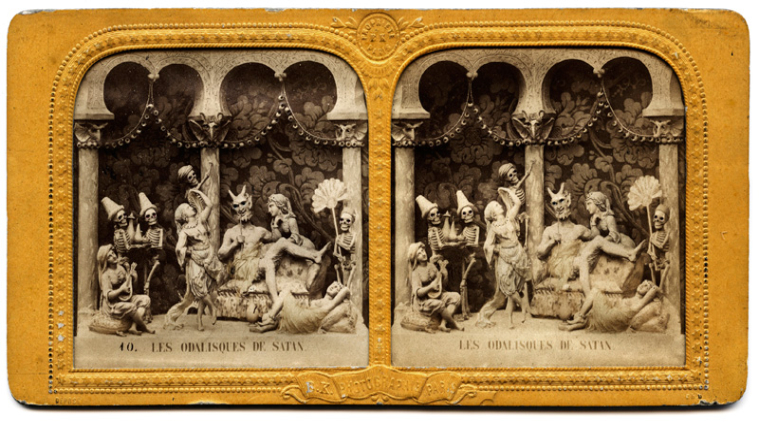 A Diablerie French Tissue stereo card. (Image credit: The London Stereoscopic Company)
A Diablerie French Tissue stereo card. (Image credit: The London Stereoscopic Company)
Brewster’s stereoscope came at a time when photography had already been invented. That was a game changer because Brewster’s stereoscope could display not only hand dressings but also crisp photographs taken from cameras. The lenticular stereoscope was a commercial success and gained mass popularity after Brewster marketed the idea to Queen Victoria in 1851 at the Great Exhibition.
The Queen was so impressed with the device that she ordered a few hundred to be made. In a matter of a few months, the public’s interest in stereoscopes and stereo images saw a steady rise with hundreds of 3D viewers sold. The stereoscope began as a device for wealthy Victorians but soon it gained mainstream status, with many discovering the world outside of England for the first time.
In 1854, the London Stereoscopic and Photographic Company was set up. The company’s popularity peaked in the 1850s when they were a leading producer of stereo cards and viewers, with a wide network of offices. In fact, London Stereoscopic employed hundreds of photographers who were tasked to travel across the world and take pictures. These pictures or stereo cards as they were known back then were used for education and entertainment.
People could view and attend virtual events as if they were physically present, while students could learn important science concepts in 3D. Stereo cards gave an impression of a time machine, going back to critical moments in history.
Stereo cards were being produced on paper, glass, and paper. They were usually mounted and had information about the publisher, photographer, and the list of views available from the photographer or publisher.
 Holmes stereoscope.(Image credit: Science Museum Group Collection
Holmes stereoscope.(Image credit: Science Museum Group Collection
Millions of stereo viewers and stereo cards were produced between the 1850s and 1930s. The popularity of stereo cards can be gauged from the fact that amateur photographers and publishing houses were making them. Selling stereo cards was quite lucrative. They were sold through mail orders, drug stores, and photographic studios. Underwood & Underwood, an American company, which at one time was the largest producer of stereoviews worldwide, churning out 25,000 prints a day.
As the popularity of stereo viewers grew, experiments were being done to improve the form and design of stereoscopes. In 1861, Oliver Wendell Holmes, a physician, with the help of Joseph L Bates, tweaked the design of the stereoscope by modifying the viewing distance and making it less heavy. This hand-held stereoscopic viewer required the photograph to be placed in the holder, which can be moved closer to or further from the eyepiece to adjust the focus as per the user’s comfort.
Holmes engineered the stereoscope in such a way that it could bring the cost down with mass production. Because Holmes didn’t patent the design, America, a young country, saw an opportunity in the stereography boom.
All through the late 1880s, stereoscopy saw dizzying heights. Eventually, the stereograph saw a reversal in popularity as people started to copy each other’s work. Because there were no copyright laws in place back then, stereo cards lost their value.
There was also the problem of bigger companies controlling the market for stereo cards, leaving no space for smaller photography firms to grow. What eventually killed the stereograph was the popularity of postcards in the 1910s which were not only more personal but also a critical means of connecting people with each other.
Revival of 3D photography
From the 1930s through the 1960s, photography saw its “golden age,” where photographs were seen as a form of self-expression and also an important way of receiving news. Innovations like film rolls and compact Leica 35mm cameras made photography more portable. During that time, stereo photography got a second lease of life with access to improved technology and innovation in photography.
The credit for reintroducing stereo photography goes to Seton Rochwite, an engineer, who approached the David White Company, an instrument maker, with the idea of a new type of stereo camera. Rochwite’s stereo camera, known by the name of the David White Co Stereo Realist, was by far the most popular 3D camera of its time. The camera used “Realist format”, based on a 35 mm film, which was the default standard for stereo photography in the 1940s.
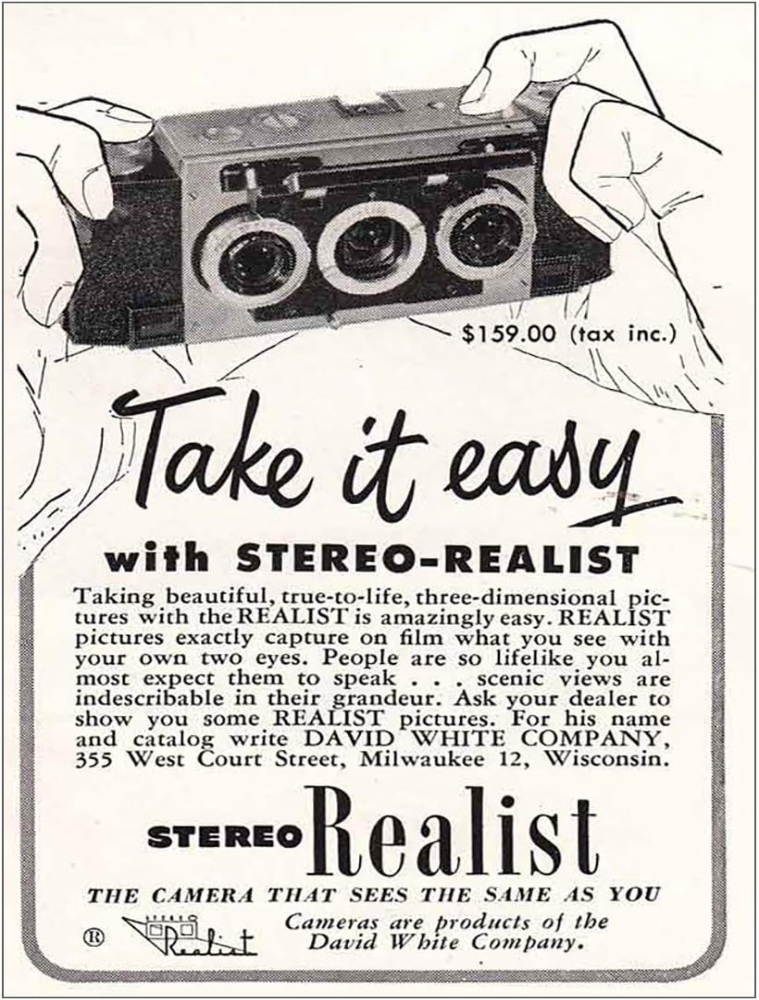 The Stereo Realist was a stereo camera that was manufactured by the David White Company from 1947 to 1971.
The Stereo Realist was a stereo camera that was manufactured by the David White Company from 1947 to 1971.
Rochwite’s idea was simple. When a photograph was taken, two separate images were recorded on the film, one from each ocular viewpoint. When the slides were viewed simultaneously through a lighted viewer, the two images blended together to reproduce the subject in 3D. Upon its launch in 1947, the Stereo Realist camera became a sensation and was endorsed by American actors such as James Cagney and John Wayne.
By the middle of the 1950s, Kodak, Revere, Graflex, and TDC came up with their own 3D cameras. Kodak launched a stereo camera in 1954 at half the price of the David White model. It was a compact camera, came with a manual shutter and aperture, and the viewfinder included a spirit level, which kept the horizon straight and further optimised the 3D effect. Kodak managed to sell 100,000 units of its stereo camera, becoming an instant hit.
The Revere Stereo 33 was another popular stereo camera of its time. Like the Kodak Stereo, it had manual shutter and aperture controls but also incorporated a rangefinder for focusing.
As photography advanced over the years, stereoscopy progressed too. From the introduction of Kodachrome film to View-Master reels and viewers, stereoscopic photography introduced the world to the third dimension but interest in stereo photography started to decline in the mid-50s. The David White Company, the makers behind the Stereo Realist, continued to make stereo cameras until 1972 when they ceased production. In its lifetime, the David White Company sold 2,50,000 stereo cameras.
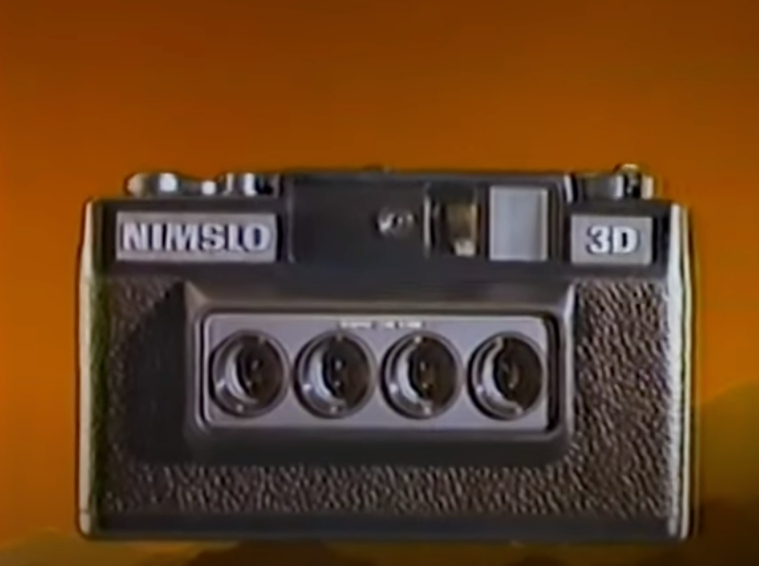 The Nimslo was a four-lensed 3D camera produced and released commercially in the early 1980s.
The Nimslo was a four-lensed 3D camera produced and released commercially in the early 1980s.
If you dig enough, stereoscopy and stereoscopic photography weren’t completely abandoned by manufacturers despite a decline in the popularity of 3D photography in general. The 80s, especially, saw the launch of a new type of stereo camera on the market. Nimslo was one of them. It was a quadrascopic stereo camera, the first of its kind 3D lenticular camera that produced 3D prints without needing to be placed in a viewer to view the 3D effect. It was produced in the 1980s by Nimstec Atlanta, Georgia, US.
Despite the hype, Nimslo was never a success. Because the camera wanted to achieve a stellar 3D effect on a flat paper (the Nimslo used a 35 mm film), it never lived up to the expectations. Those who used the Nimslo camera complained of missing 3D effects when taking pictures because of how the device was designed. Since the camera was made for only close-range subjects, it wasn’t able to bring the right 3D effects when the subject was far from the camera.
Despite the failure of the Nimslo camera, several companies, including Nishika, Image Tech, Nimstec, Rittai and US Tech, tried to launch and experiment with quadrascopic stereo cameras but ultimately failed.
 The Fujifilm FinePix Real 3D W1 camera used a lenticular screen process so each eye sees a slightly different image.
The Fujifilm FinePix Real 3D W1 camera used a lenticular screen process so each eye sees a slightly different image.
It wasn’t until 2010, 3D stereo cameras were brought back from the dead but this time they came in a digital avatar. Fujifilm released the FinePix Real 3D W1, the world’s first 3D stereo digital camera. The camera was built on the stereo vision technique of estimating the depth of point of an object from the camera’s two lenses. Not only did the camera come with the ability to record 3D images and 3D HD videos but it also had a 3D display that didn’t require wearing special glasses. Unfortunately, the W1 camera had a lot of flaws. Although you could see 3D pictures on the camera’s screen, there was no provision to see 3D effects on your PC; and if you wanted prints these had to be produced by Fujifilm. The W1 was later replaced by a more affordable Fuji W3. The new camera offered a higher resolution LCD display but at the cost of reduced lens spacing and reduced stereo effect.
But Fuji wasn’t the only company thinking about 3D digital stereo cameras. German camera manufacturers Rollei and ViewSonic also brought stereo cameras to the market. All those cameras were poorly made and distributed with the exception of Panasonic Lumix 3D1.
![]() The 3D format got a major boost with the release of Cameron’s 2009 blockbuster “Avatar,” which till date continues to be one of the highest-grossing movies of all time. (Image credit: Disney)
The 3D format got a major boost with the release of Cameron’s 2009 blockbuster “Avatar,” which till date continues to be one of the highest-grossing movies of all time. (Image credit: Disney)
Throughout the early 2010s, 3D was a big tech trend. In fact, the entire industry was betting on 3D technology at one point. Imagine a brand like Sony was producing 3D camcorders, 3D TVs, 3D Blu-ray players and even 3D content in an attempt to create an ecosystem. Meanwhile, companies such as HTC and LG were launching 3D smartphones in the market. It was the time when James Cameron’s Avatar was released, taking 3D film technology to the next level.
3D both as a technology and as a form of storytelling was compelling enough, though it appeared more of a fad than a true game changed the industry initially hoped for. The industry had also started to realise that 3D technology was way too challenging for both hardware manufacturers and content providers. Truth be told, the lack of advanced glasses-free 3D portable displays was the biggest reason why 3D photography never took off. From 3D digital stereo cameras to 3D-capable smartphones, all options lacked high-resolution displays to accurately show the 3D effect. No wonder consumers rejected 3D cameras as well as 3D content.
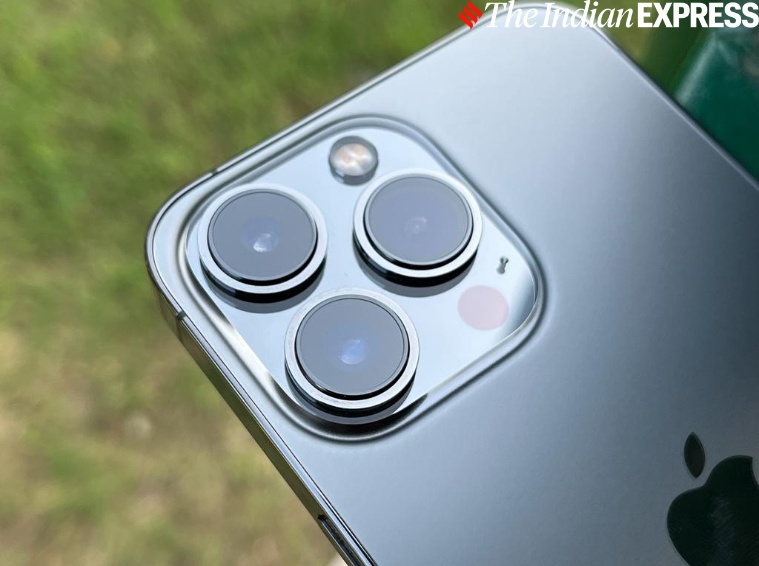 The high-end iPhone has a 3D camera, but it’s not made for 3D photography. (Image credit: Anuj Bhatia/Indian Express)
The high-end iPhone has a 3D camera, but it’s not made for 3D photography. (Image credit: Anuj Bhatia/Indian Express)
Can Apple’s Vision Pro bring 3D cameras back into fashion?
We don’t know if 3D photography will ever bounce back and regain its Victorian-era pinnacle. Currently, the interest in stereo photography is limited to stereo photographers and collectors. But Apple has a track record of giving a mass push to many technologies.
The Vision Pro can both capture and playback 3D content. But, unlike stereophonic 3D cameras of the past, the device promises a more immersive experience due to the headset’s ability to show the captured content in a full 3D VR setting. If it works well as advertised, it could open new ways of capturing and consuming 3D content through a headset, and eventually help create a cohesive ecosystem.
One wonders if future versions of the iPhone would also capture and playback 3D photos and videos like the Vision Pro. Well, the answer is not as simple as it appears to be. Technically, the iPhone has a 3D camera but it’s not designed for 3D photography. The iPhone 14 Pro Max, for that matter, uses a Lidar sensor, which is different from stereoscopic 3D cameras. Lidar is a type of 3D time-of-flight sensor that adds depth sensing for better photos and augmented reality. Stereoscopic 3D cameras, on the other hand, work similarly to a pair of human eyes.
[ad_2]










